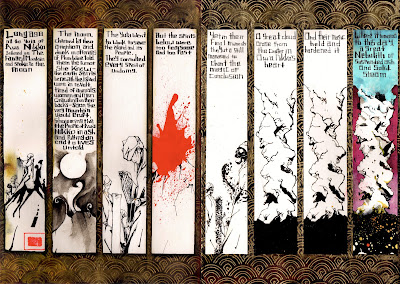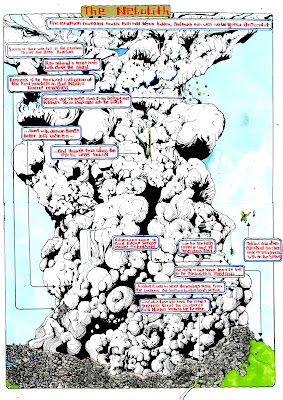Material
When interviewers ask me about how I approach writing RPG stuff I usually say something like "It's a lot like writing a novel or other story, you just do it like that."
I realize that might not be the most useful way to put it, so I am going to dig a little into what that means.
The word dressmakers use for stuff that they're going to make into a dress is the same word comedians have for words they're going to turn into a performance: "material". Like: "I need more material,""This is great material,""All out of material," "You need new material", etc.
Material means, in writing: everything in your head that you think might interest your audience that you have not told them already. Material is unformed. It is a thing but not yet presented or presentable.
One way to think about writing that is helpful to me when I'm doing RPG stuff is to describe writing as a process of translation. Material appears in the inchoate language of thought and leaves in the language of, well, language.
When I say writing an RPG thing is like writing a story, remember a story's not just you revealing the plot points in order, it's you revealing anything you want to reveal.
Tolkien begin his whole saga with no plot at all, with barely even a description, but rather by revealing what some things in his story aren't:
In a hole in the ground there lived a hobbit. Not a nasty, dirty, wet hole, filled with the ends of worms and an oozy smell, nor yet a dry, bare, sandy hole with nothing in it to sit down on or to eat: it was a hobbit-hold, and that means comfort.
The plot has gone nowhere and he's already got three lines. Rock on. He did it by thinking about what his story wasn't about, and giving us those thoughts.
If you haven't revealed it yet--or haven't revealed that's what you think yet--that's material.
One way to think of writing:
1. Know what your material is.
2. Reveal it in the most interesting order you can.
3. Reveal it using the most interesting words you can.
Old Material
Material does not have to be something you know but the audience doesn't. You know what an elephant is, but Samuel Johnson is going to tell you anyway:
"The largest of all quadrupeds, of whose sagacity, faithfulness, prudence, and even understanding, many surprising relations are given. This animal is not carnivorous, but feeds on hay, herbs, and all sorts of pulse; and it is said to be extremely long lifed. It is naturally very gentle; but when enraged, no creature is more terrible. He is supplied with a trunk, or long hollow cartilage, like a large trumpet, which hangs between his teeth, and serves him for hands: by one blow with his trunk he will kill a camel or a horse, and will raise a prodigious weight with it. His teeth are the ivory so well known in Europe, some of which have been seen as large as a man's thigh, and a fathom in length. Wild elephants are taken with the help of a female ready for the male: she is confined to a narrow place, round which pits are dug; and these being covered with a little earth scattered over hurdles, the male elephants easily fall into the snare. In copulation the female receives the male lying upon her back; and such is his pudicity, that he never covers the female so long as any one appears in sight."
How did he take something we all know and keep us entertained all the way through telling us it? Let's take a look at one part we didn't need to know:
He is supplied with a trunk, or long hollow cartilage, like a large trumpet..."
We get "supplied" which is wonderful (because although it's technically appropriate, it summons an image of a uniformed clerk carrying one under his arm to the noseless elephant), there's something great about the forensic precision of "cartilage" leading casually into the bombastic street-party atmosphere of "trumpet".
Here's Paul F Tompkins telling us what we already know about peanut brittle:
This bit--this transformation of the idea material of "Hey, the peanut brittle gag is anachronistic" into five minutes of stage time--consists of just saying what we know over and over, slowly, teasing out every bit of absurdity. "..this peanut brittle--the most common snack in the world--".
Efficiency
One thing none of these uses of material I've quoted so far is, is efficient. The information's not delivered quickly. The ratio of word to idea is quite high.
It is, however, delivered entertainingly, which is to say: memorably.
I don't have much of a head for recipes, but I certainly remember Harry Nilsson's doctor's formula for gastrointestinal relief: you put the lime in the coconut and drink em both up. Because Tarantino put it in that movie.
RPG writing has a challenge embedded in it--as I've said often, we often want to be able to access rules quickly midgame (that is: we want efficiency) but we also want the rules to be fun to read and (therefore) easy to remember so we don't have to look them up much.
Whenever possible in an RPG, I would not recommend trying to balance the imperative to be efficient with the imperative to be memorable. I would instead recommend just doing both: put a memorable version of the concept in the text, and make an efficient, referenceable version elsewhere, and then make sure you and the graphic designer find ways to tell the reader which is which.
Wasting Material
You can waste material. You can take a perfectly good thought and reveal it in such a way that the juice of what you need to tell the reader stops feeling worth the squeeze of patiently reading those words in order.
Here's Samuel Johnson on "pig":
A young sow or boar.
Fuck off, Sam. We get a 203-word disquisition on the elephant and yet his cousin the hog--a noble, tasty beast, an ally and associate to humanity since well before the bronze age--isn't worth even a full line?
Samuel Johnson has wasted his material.
As demonstrated above, you don't waste material by telling the reader what they already know. That's fine: readers can love reading what they already know and many RPG authors make entire careers dictating readers' own thoughts back to them. You waste material by not presenting it as being as exciting or rich as it actually is to you. Vegetarians want pigs around, carnivores want pigs around, maybe even more--so, really, everyone wants pigs around. Make us know why.
Writing is revealing your thoughts, nobody wants to hear thoughts not even you think are interesting.
Let's see what else Johnson did with a pig:
Sow-- A female pig; the female of a boar.
Zzzzzz. You would not hire this man to write your monster manual.
Now:
Boar--The male swine.
Triple fuck off! Ok, fine, Johnson is bored but out of sheer bloodymindedness, let's see "swine":
Swine--A hog; a pig. A creature remarkable for stupidity and nastiness.
Finally the doctor has done something with his material. We now know two things about pigs. We don't know how many legs they have but whatever, something has been revealed, and it's interesting: pigs apparently suck, or at least Samuel Johnson thinks they do.
And a hog?
Hog--The general name of swine.
I'm belaboring the point.
-
-
-
What you must say is a pig, what the audience will read is a sausage. Make the transition with grace, and honor every part of the pig.
-
-
-













